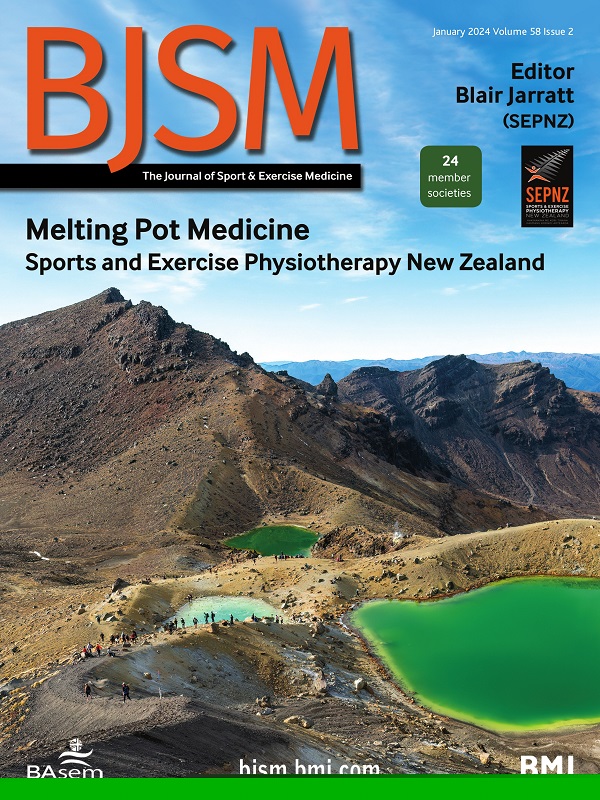Global cardiac screening practices among youth and adult football players: the FIFA cardiac screening survey
IF 16.2
1区 医学
Q1 SPORT SCIENCES
引用次数: 0
Abstract
Objective To investigate global cardiac screening practices among elite male and female football players. Methods We surveyed all 211 FIFA Member Associations (MAs) between February and July 2024 using a 21-point questionnaire. Results A total of 165/211 (78%) MAs completed the survey. Cardiac screening was recommended or mandated by 81% (134/165) of responding MAs, with a variation between FIFA Confederations ranging from 33% (3/9 of MAs within the Oceania Football Confederation) to 100% (10/10 MAs within the South American Football Confederation). The majority of MAs use a protocol inclusive of at least medical history, physical examination and 12-lead ECG for adult male (123/134, 92%), adult female (119/134, 89%), youth male (112/134, 84%) and youth female (108/134, 81%) players. The inclusion of echocardiography was more common among adult male (91/134, 68%) and female (84/134, 63%) players compared with youth male (59/134, 44%) and youth female players (59/134, 44%). Among youth players, the age at initial cardiac screening (median age (IQR)=14 (4) years, range: 6–17 years) and the interval of serial screening were highly variable. Conclusion Routine cardiac screening is widely, but not uniformly, applied across football associations globally. There is considerable variation in cardiac screening practices based on geography and player age, suggesting that standardised global recommendations for cardiac screening in both adult and youth football are needed. No data are available.青少年和成年足球运动员的全球心脏筛查实践:国际足联心脏筛查调查
目的调查全球优秀男女足球运动员的心脏筛查情况。方法我们在2024年2月至7月期间对所有211个国际足联成员协会(MAs)进行了21点问卷调查。结果165/211名(78%)ma完成调查。81%(134/165)的应答MAs建议或强制进行心脏筛查,各国际足联联合会之间的差异从33%(大洋洲足球联合会的3/9)到100%(南美洲足球联合会的10/10)不等。对于成年男性(123/134,92%)、成年女性(119/134,89%)、青年男性(112/134,84%)和青年女性(108/134,81%)球员,大多数MAs采用至少包括病史、体格检查和12导联心电图的方案。超声心动图检查在成年男性(91/134,68%)和女性(84/134,63%)球员中较年轻男性(59/134,44%)和年轻女性(59/134,44%)球员中更为常见。在青少年球员中,初始心脏筛查的年龄(中位年龄(IQR)=14(4)岁,范围:6-17岁)和连续筛查的间隔时间变化很大。结论常规心脏筛查在全球足球协会广泛应用,但并不统一。基于地理位置和球员年龄,心脏筛查实践存在相当大的差异,这表明需要对成人和青少年足球的心脏筛查进行标准化的全球推荐。无数据。
本文章由计算机程序翻译,如有差异,请以英文原文为准。
求助全文
约1分钟内获得全文
求助全文
来源期刊
CiteScore
27.10
自引率
4.90%
发文量
217
审稿时长
3-8 weeks
期刊介绍:
The British Journal of Sports Medicine (BJSM) is a dynamic platform that presents groundbreaking research, thought-provoking reviews, and meaningful discussions on sport and exercise medicine. Our focus encompasses various clinically-relevant aspects such as physiotherapy, physical therapy, and rehabilitation. With an aim to foster innovation, education, and knowledge translation, we strive to bridge the gap between research and practical implementation in the field. Our multi-media approach, including web, print, video, and audio resources, along with our active presence on social media, connects a global community of healthcare professionals dedicated to treating active individuals.

 求助内容:
求助内容: 应助结果提醒方式:
应助结果提醒方式:


